Comtarsia Logon Client 7.0
Table of Contents
- 1. Introduction
- 2. Installation
- 3. Comtarsia Management Console (ComtMC)
- 4. Basic Configuraion
- 5. Usage Scenarios
- 6. Configuration Parameters
- 6.1 Logon Client
- 6.2 LDAP
- 6.3 User Object
- 6.4 Groups
- 6.5 SyncClient
- 6.6 Logon
- 6.7 PKI
- 6.8 Groups - Groupmapping
- 6.9 Variables
- 7. Logging
- 8. Parameter Description
- 8.1 [HKLM\SOFTWARE\Comtarsia]
- 8.2 [.\SignOn Solutions 7.0]
- 8.3 [.\SignOn Solutions 7.0\Components]
- 8.4 [.\SignOn Solutions 7.0\DefaultProfiles]
- 8.5 [.\SignOn Solutions 7.0\LogonClient]
- 8.6 [.\SOSProfile *]
- 8.7 [.\SOSProfile *\Group]
- 8.8 [.\SOSProfile *\GroupMapping]
- 8.9 [.\SOSProfile *\LDAP]
- 8.10 [.\SOSProfile *\LDAP\Servers]
- 8.11 [.\SOSProfile *\LDAP\Servers\<LDAP-Server>]
- 8.12 [.\SOSProfile *\Log]
- 8.13 [.\SOSProfile *\Log\SysLog]
- 8.14 [.\SOSProfile *\SyncClient]
- 8.15 [.\SOSProfile *\UserCertificateMapping]
- 8.16 [.\SOSProfile *\UserCertificateMapping\ <UserCertificateMappingName>]
- 8.17 [.\SOSProfile *\Variables]
- 8.18 [.\SOSProfile *\Variables\BeforeSync]
- 8.19 [.\SOSProfile *\Variables\AfterSync]
- 8.20 [.\SOSProfile *\Variables\<VariableEffectivePoint>]
- 8.21 [.\SOSProfile *\Variables\<VariableEffectivePoint>\<VariableName>]
- 8.22 [.\SOSProfile *\UserEnvironment]
- 8.23 [.\SOSProfile *\LogonClient]
- 8.24 [.\SOSProfile *\LogonPolicy]
- 8.25 [.\SOSProfile *\Script]
- 8.26 [.\SOSProfile *\SSO]
- 9. 8. Disclaimer
Version: 7.0.5.1, July 12, 2025
1. Introduction
Comtarsia Logon Client 7.0 for Windows Workstation and Server
Supported Platforms: Windows 10/11, Windows Server 2016/2019/2022/2025
Primary LDAP authentication on the local or virtual Desktop via Password or Smart Card.
The Comtarsia Logon Client supports different Multi-Factor Authentication (MFA) types (TOTP, HOTP, FIDO2, COTP ) to be used as a second factor for user authentication. See the document “Comtarsia Multi-Factor Authentication Guide” for more details: http://signon.comtarsia.com/Downloads/Englisch/Comtarsia_Multi-Factor_Authentication_Guide.pdf
Direct LDAP authentication or via SignOn Proxy. Local User Mode or Domain User Mode with automatic User Managment by using the SignOn Agent for Active Directory
Supported LDAP Server: IBM Tivoli Directory Server, Open LDAP, Open Directory (Mac OS X), Fedora Directory Server, Novell eDirectory Server, IBM z/OS SecureWay (RACF), Sun DS Enterprise Edition, Lotus Domino, Microsoft Active Directory (via LDAP)
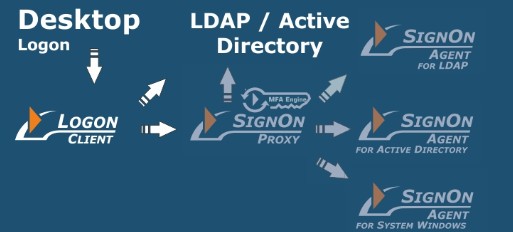
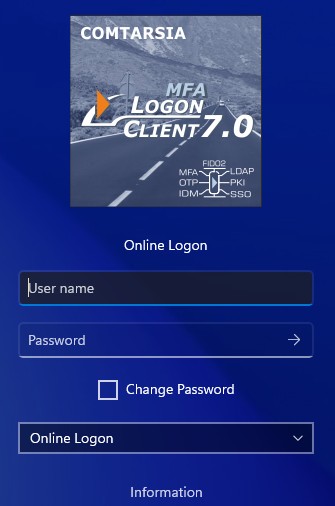
The Credential Provider interface is used by the Comtarsia Logon Client 7.0 which replaces the Microsoft Logon tile by a Comtarsia Logon tile which enables the LDAP logon. It’s possible to configure the Comtarsia Logon Client 7.0 so that users can switch back to the Microsoft Logon tile, or to forbid any other authentication method beside LDAP/Comtarsia SignOn Proxy.
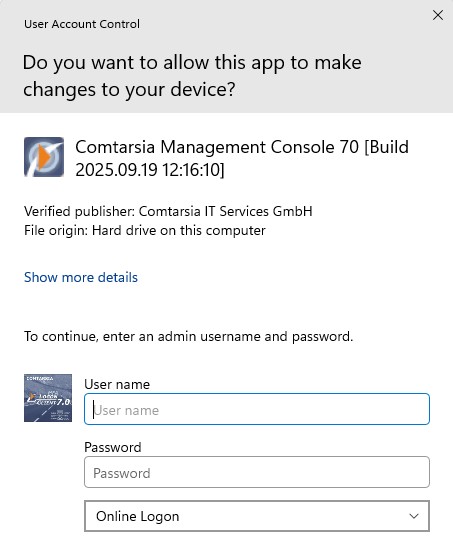
The Windows User Account Control (UAC) allows a specific authorisation for the execution of applications which need local Administrator rights. The Comtarsia Logon Client 7.0 enables the possibility to use LDAP groups to control these temporary administrator privileges.
2. Installation
2.1 Manual Installation
An installation or an update is done using the installation program “SOS7.0-7.0.x.1.exe”. When updating, the configuration is preserved and the license key will only be replaced if the validity of the installed key is shorter than the validity of the key shipped with the installation program. (Bought license keys usually won’t be replaced.)
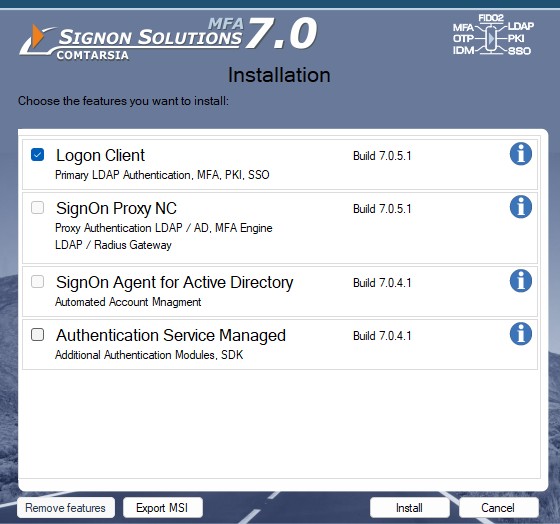
The installation program copies the necessary files and applies necessary registry changes to enable the Comtarsia Logon Client Credential Provider tile. It also writes a default configuration into the registry (except for those values which have already been set – no existing config will be replaced).
2.2 Software Distribution
All SignOn Solution 7.0 components are provided as separate MSI packages. To get this packages, just run the SignOn Solutions 7.0 bundle installer and on the feature selection screen press “Show MSI”.
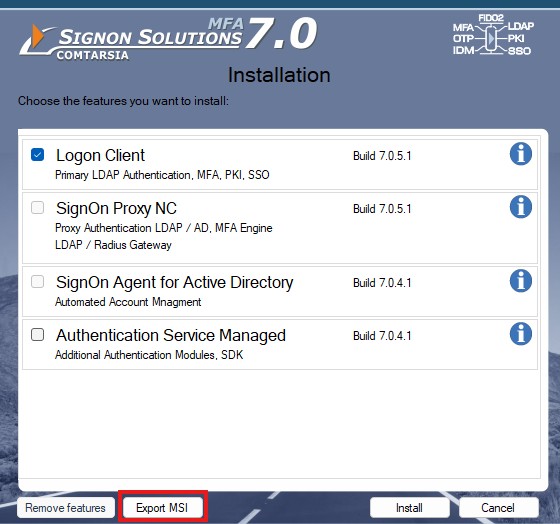
For some products an initial configuration is supplied in form of a mst-file (MSI Transform). If you prepare a package for software distribution, you should omit this initial mst file and replace it with your own configuration and support files (Licence key, certificates, customized images).
The complete Logon Client configuration is stored under the registry key “HKLM\Software\Comtarsia\SOSProfile 001”.
The licence key to use is configured under “HKLM\SOFTWARE\Comtarsia\SignOn Solutions 7.0\LicenceKeys\004”. This registry key and also the licence key file itself has to be included in the software distribution package.
3. Comtarsia Management Console (ComtMC)
The Comtarsia Management Console (ComtMC) can be accessed through the Start menu.
On the first start of the ComtMC one will be asked whether “automatic update checking” should be enabled or disabled. If there’s no direct internet connection (internet accessible without proxy server), it’s advisable to disable automatic update checking for now. This setting can be adjusted at a later time. See: Update Notification
3.1 Update Notification
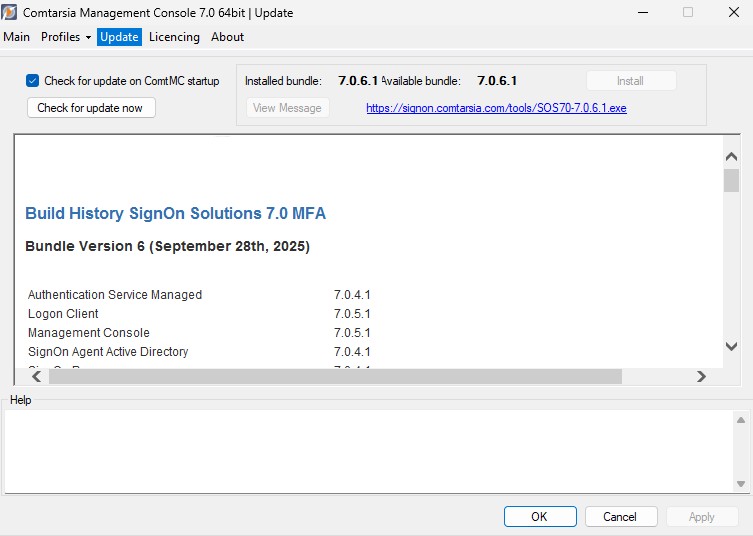
The version checking and notification is performed each time the ComtMC is started.
If there’s no direct internet connection (internet accessible without proxy server), it’s advisable to disable automatic update checking for now. The update check is carried out exclusively over http://update.comtarsia.com
A manual check (Check for update now) can be triggered via the “Update” tab of the ComtMC.
4. Basic Configuraion
The configuration of the LDAP settings builds the fundament on which all configuration scenarios build upon.
The following information is needed:
- LDAP-Server Adress/Port Non-SSL or SSL
- LDAP server type (eg: OpenLDAP, IBM Directory Server 6, etc)
- LDAP directory structure
- 1 LDAP user with password (for testing)
LDAP directories usually don’t follow any rigid pattern and are usually tailored to fit company scenarios and applications. Therefore, the LDAP configuration of the Comtarsia Logon Client often just cannot be done by following a simple recipe.
This section shows how to obtain a basis configuration which allows an LDAP logon, by following a few simple steps. Additional scenarios which can be used to refine that “simple configuration” follow later together with the required configuration steps. See: Usage Scenarios
To keep the fundamental configuration simple, it is assumed that all LDAP users are in the same container.
In the hirarchy of the example-LDAP server “ldap.comtarsia.com”, the user “mamu1” is in the container “ou=users” which in turn is in “o=comtarsia”. “o=comtarsia” is also the BaseDN. The naming-attribute of the example users is “uid”. (usually “uid” or “cn”)
The full DN (Distinquished Name) of the user is therefore: “uid=mamu1,ou=users,o=comtarsia”.
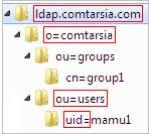
The syntax of full DNs is always from the lower level (leaf) to the base object (root or “baseDN”).
LDAP servers can usually accessed unencrypted over the port 389, as well as SSL-encrypted over the port 636. For the first tests, with the test users, an unencrypted (clear text) communication is sufficient. In production environment, however, an encrypted communication is for security reasons strongly recommended; because otherwise, any communication between the client and the LDAP server (including login information) is held in clear text.
The first configuration to be made is in the Comtarsia Management Console (ComtMC) in the tab “ LDAP -> Server”; The LDAP host name (or IP-address), the LDAP port and the corresponding SSL mode.
If the LDAP communication should be encrypted (over SSL), it’s best to chose “SSL without trusted server certificate” instead of “No SSL” for now, for the sake of simplicity. For more information concerning the SSL modes, see: LDAP over SSL
Also important is the “BaseDN” which is the base of every LDAP-search.
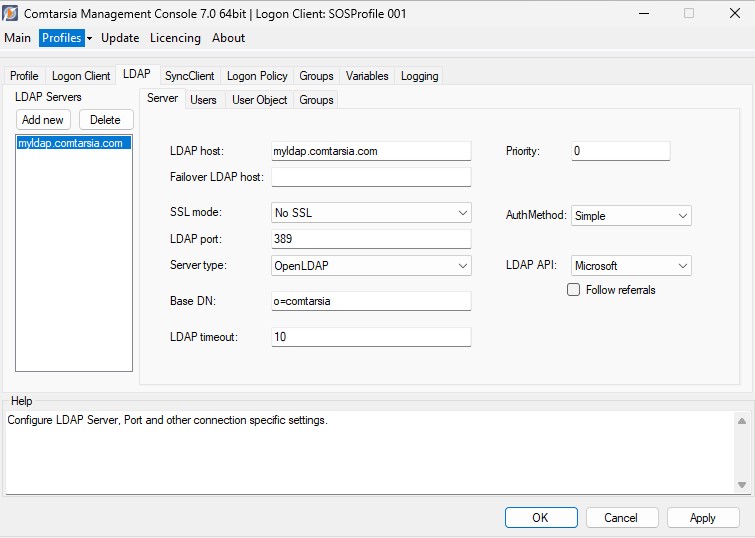
The tab “ LDAP -> Users ” contains the configuration of the position of LDAP-users within the LDAP directory, or “how the authentication” should be performed.
The simplest “UserDN Mode” is “Static DN”. In this mode, the Comtarsia Logon Client uses logon name entered by the user (at the logon tile) and uses it to construct an LDAP DN with that name and the configured “BaseDN, UserDN Suffix, and UserDN Prefix”. Subsequently, the Comtarsia Logon Client uses that constructed LDAP DN and the password for an LDAP-bind to the configured LDAP server. If the LDAP server accepts that LDAP-bind with the constructed LDAP DN and password, the provided username is considered valid and the logon process continues.
The UserDN is constructed in the following way:
UserDN Prefix +
The assembly of those parts must result in a valid LDAP DN.
In the example, this results in:
UserDN Prefix=„uid=“
UserDN Suffix=„,ou=Users“ (inclusive the comma)
BaseDN=„o=Comtarsia“
The Comtarsia Management Console shows a preview of the resulting UserDN, so that one can see at a glance whether the chosen values are entered correctly and meet the existing LDAP structure. (marked red in the picture below)
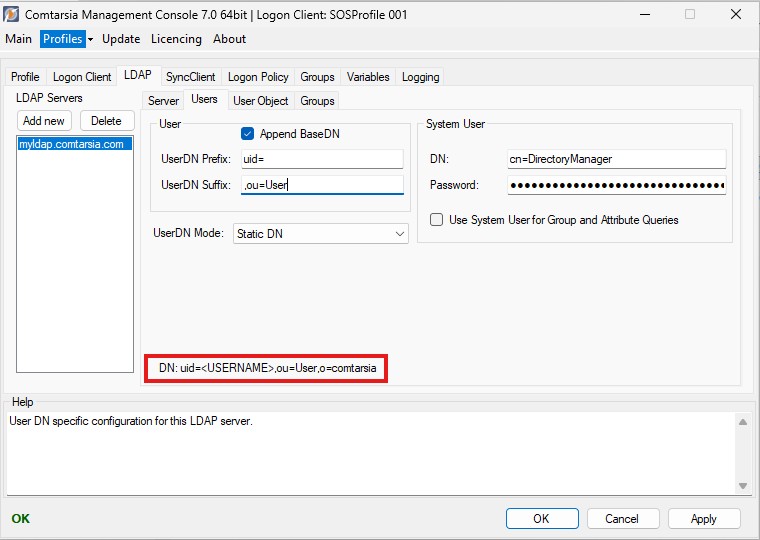
5. Usage Scenarios
5.1 LDAP over SSL
There are different modes of communication between the Comtarsia Logon Client 7.0 and the LDAP server. The basic idea of the SSL communication is the encryption of the plaintext data which is sent over the wire. (1st mode).
The 1st mode is the easiest to configure.
The settings are made in the ComtMC in [ LDAP -> Server -> SSL mode ].
Description of the modes:
Mode 1: SSL without "trusted server certificate"
Requirements:
Client: none
LDAP Server: SSL communication (ldaps) has to be enabled. The certificate doesn’t have to be issued by a CA (Certificate Authority) – it may as well be a self-signed certificate.
Advantages: The communication between the Comtarsia Logon Client 7.0 and the LDAP server, (which will otherwise be in clear text) will be encrypted.
Mode 2: SSL with "trusted server certificate"
Requirements:
Client: The client has to trust the CA (Certificate Authority) which issued the LDAP server certificate. Therefore, all CA-certificates in the chain have to be added to the “Trusted Root Authorities”-branch of the computer-certificates-store. (see figure below)
LDAP Server: The certificate of the LDAP server has to be issued by a certificate authority which is trusted by the client.
Advantages: Encryption. The Comtarsia Logon Client ensures that the LDAP server is trusted by checking its certificate. (prevents “man in the middle”-attacks)
Mode 3: SSL with "trusted client certificate"
Requirements:
Client: As mode 2. In addition, the client needs a client certificate (inclusive key) in the “My”-branch of the computer certificates store. The certificate of each client has to have the computer name its client as part of the certificate CN (common name). (see figure below)
LDAP Server: As mode 2. In addition, the LDAP server has to trust the certificate authority which issued the client certificate.
Advantages: Like mode 2. The LDAP server can be configured to only accept connections from trusted clients.
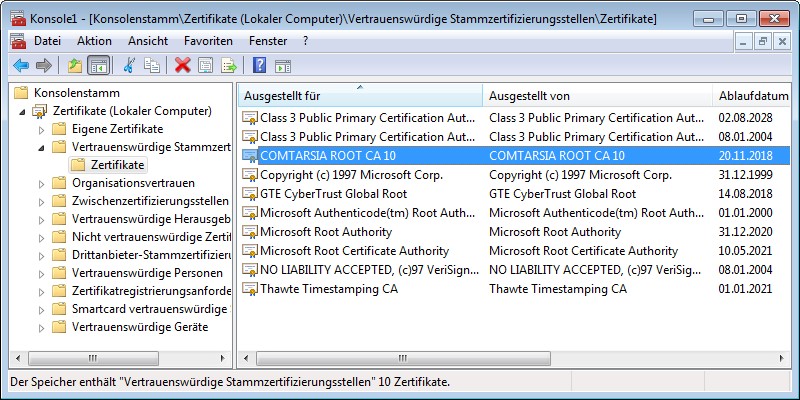 [Figure: MMC: Trusted Root Certificates of the computer]
[Figure: MMC: Trusted Root Certificates of the computer]
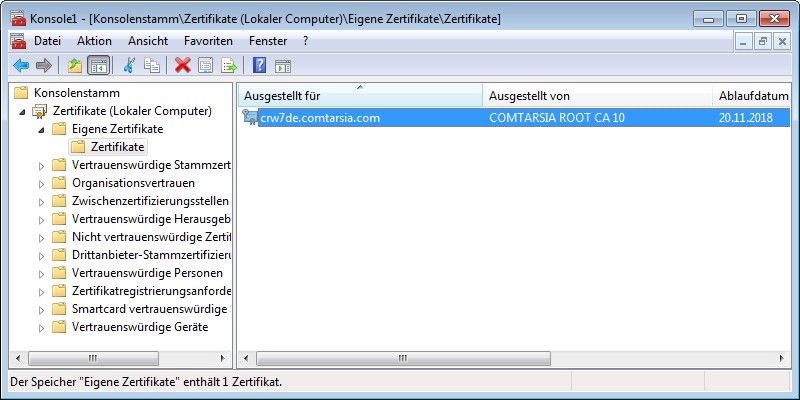 [Figure: MMC: My-store of the computer]
[Figure: MMC: My-store of the computer]
5.2 LDAP Users from Multiple OUs
Often, the LDAP hierarchy isn’t flat and the users are located in several organizational units (OU).
In the bases (example) configuration, all users are in the OU “ou=Users”, which, in turn is within the organisation “o=Comtarsia”. However, the following examples have an additional hierarchical level to show the configuration steps required to handle that “multiple Ous”-scenario.
uid=<Username>,ou=<Variable OU>,ou=Users,o=Comtarsia
eg:
uid=<Username>,ou=Human Resources,ou=Users,o=Comtarsia
uid=<Username>,ou=Public Relations,ou=Users,o=Comtarsia
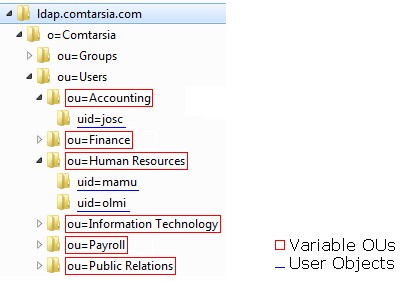 [Figure: LDAP example: multiple OUs]
[Figure: LDAP example: multiple OUs]
There are different ways to configure this (and similar) scenarios for the Comtarsia Logon Client 7.0. The first option (Search for User), simply searches for the LDAP user within the configured RootDN (on a sub-tree level). The second option (OU Searchlist) uses a list of allowed OUs, and the Comtarsia Logon Client 7.0 searches in each of those OUs for the provided LDAP-user.
In both cases, the LDAP-search either has to be allowed for “anonymous”, or a “LDAP system user” has to be used who has the rights to search within the desired parts of the LDAP directory. This system user can be set in the ComtMC and will be used by the Comtarsia Logon Client for those search operations.
5.3 Search for User
The Comtarsia Logon Client authenticates itself against the LDAP server, using the configured “System User”.
[Figure: ComtMC: LDAP > Users: UserDN Mode = Search for User]
Then, the Logon Client issues an LDAP search, which is composed as follows.:
(&(uid=<USERNAME>)(objectclass=person)) baseDN: o=Comtarsia
"USERNAME": The username entered by the user."uid=": the configured "UserDN Prefix""person": the configured "User Object > Object Class" (see figure)"o=Comtarsia"the configured "baseDN"
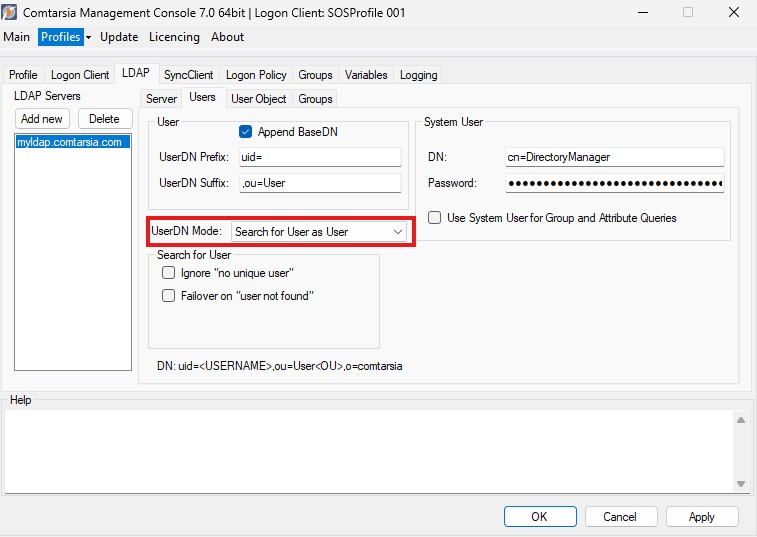 [Figure: ComtMC: ComtMC: LDAP > Users: UserDN Mode = Search for User]
[Figure: ComtMC: ComtMC: LDAP > Users: UserDN Mode = Search for User]
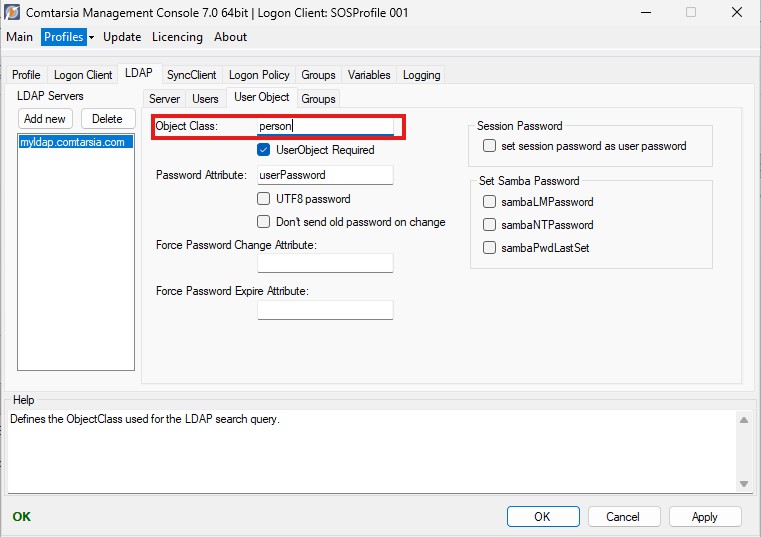 [Figure: ComtMC: LDAP > User Object > Object Class]
[Figure: ComtMC: LDAP > User Object > Object Class]
If an unique LDAP userobject is found, the full DN of this object is used for the LDAP bind request, together with the password provided by the user. In all further steps (eg: group search), this determined LDAP-user DN is used.
If the user is not unique (more than one LDAP objects got returned by that LDAP-search), the logon process will be terminated with an error message.
5.4 OU Searchlist
The Comtarsia Logon Client authenticates itself against the LDAP server, using the configured “System User”.
.After that, the Comtarsia Logon Client requests the configured “OU Searchlist > ObjectDN” and its “OU Searchlist > Attribute”. This object contains a list of valid “
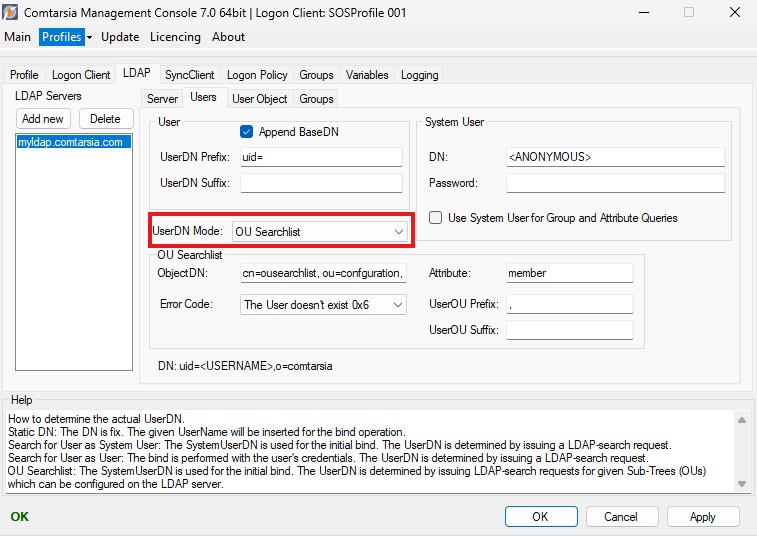 [Figure: ComtMC: LDAP > Users > UserDN Mode = OU Searchlist mode]
[Figure: ComtMC: LDAP > Users > UserDN Mode = OU Searchlist mode]
The configured OU Searchlist Object could be an LDAP group (default configuration); but it can as well be any other LDAP object. By default the “Member”-attribute of a specific LDAP group would contain all the allowed “OUs”.
Example LDIF of the OU Searchlist object:
dn: cn=ousearchlist, ou=Groups, o=Comtarsia
objectClass: top
objectClass: groupOfNames
member: ou=Accounting
member: ou=Finance
member: ou=Human Resources
member: ou=Information Technology
member: ou=Payroll
member: ou=Public Relations
cn=ousearchlist
The Comtarsia Logon Client uses the following values to generate possible valid User-DNs:
<UserDN Prefix><USERNAME><UserDN Suffix><UserOU Prefix><OU><UserOU Suffix>,<baseDN>
In the example configuration, this results in:
uid=<USERNAME>,<jeweilige OU>,o=Comtarsia
"UserDN Prefix": configured in "LDAP > Users > User > UserDN Prefix""<USERNAME>": entered by the user at the login screen"UserDN Suffix": configured in "LDAP > Users > User > UserDN Suffix""UserOU Prefix": configured in "LDAP > Users > OU Seachlist > UserOU Prefix""<OU>": replaced by the respective OUs"UserOU Suffix": configured in "LDAP > Users > OU Seachlist > UserOU Suffix""baseDN": configured in "LDAP > Server > baseDN"
The Comtarsia Logon Client checks each of the resulting DN to see if any of them is a valid LDAP user.
Once a user has been found, the full DN of that user is used, together with the password provided by the user, to issue an LDAP bind. If the LDAP bind succeeds, the logon process continues and the full DN of this user is used for all further steps (eg: group search).
If none of the resulting user-DNs is a valid user, the logon process will be cancelled and the user receives the configured “error code” (LDAP > Users > OU Searchlist > Error Code).
6. Configuration Parameters
6.1 Logon Client
Profile
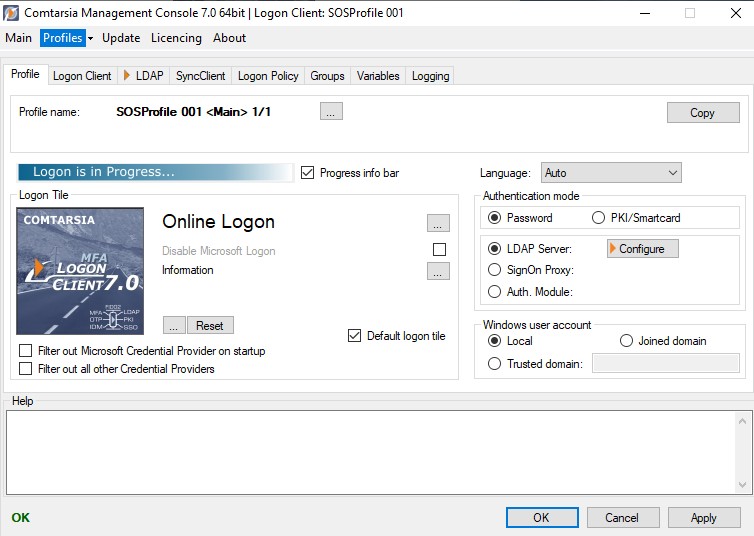
Defines the user interface language. Currently the following languages are available: German, English, and French.
Authentication mode
enableSmartcard: Allows to chose between "user password" logon or "pki" (smartcard) logon.
enableProxyLogon: "Direct": the user is authenticated (directly) against the LDAP server. "Proxy": the user credentials (user/passwor or PKI handshake) is taking place over the Comtarsia SignOn Proxy server which handles the authentication via an LDAP server.
Windows user account
This option activates/deactivates Enable Domain Logon. When set to "Local", the "Local User Mode" is active; "Joined domain" activates the “Domain User Mode”.
Local User Mode:
After a successful LDAP logon a local user account is used for the workstation logon. The user account management (create, activation, password synchronization, etc..) is performed by the Comtarsia Logon Client.
Domain User Mode:
After a successful LDAP locon a domain user account is used for the workstation logon. In order for the automatic domain logon to work, two conditions have to be met:
- The workstation has to be a member of the domain
- Since the Comtarsia Logon Client doesn’t have the necessary privileges to manage AD-users, the Comtarsia SignOn Gate has to be used on one of the AD servers, and the Comtarsia Logon Client has to be configured to use it. See: SyncClient Configuration.
Microsoft Credential Provider – Filter:
The Comtarsia Logon Client allows you to filter out the standard Microsoft Credential Provider. I.e. Users can’t switch to the Microsoft Credential Provider at the the logon- or unlock-screen. The Button “other user” is no longer available.
If this parameter is enabled, the Microsoft Credential Provider won’t be loaded during the system start. (Comtarsia Credential Provider will be shown as default, but unless “Disallow temprary activation/deactivation” is also enabled, users can still switch to the Microsoft Credential Provider)
If this option is active, the link “Enable/Disable Microsoft Logon” (at the login screen) is no longer available.
If this parameter is activated, a progressbar is displayed on top of the screen during the logon.

With this parameter, an alternate bitmap (for example a company logo) can be chosen which replaces the Comtarsia logo in the Logon tile.
The bitmap has to have a resolution of 126x126 pixel and has to be locally available to the system during the logon.
Quick Logon
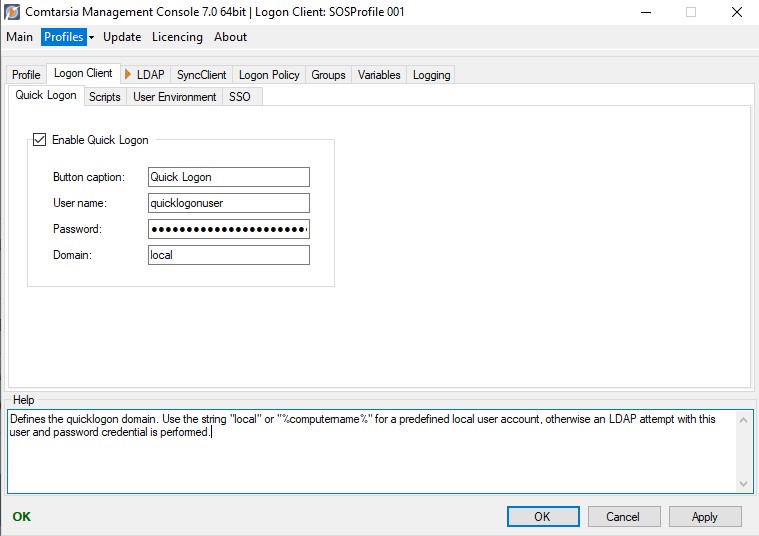
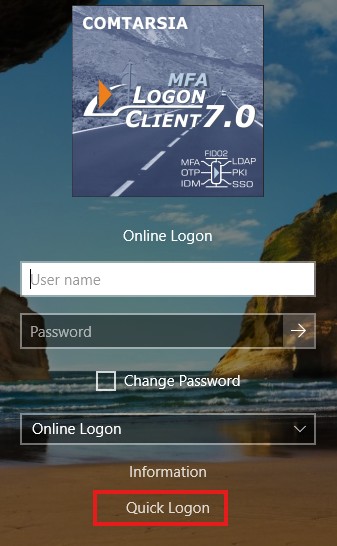
Activates a "Quick Logon" button on the logon screen which allows users to log on with predefined credentials (1-click logon)
Specifies the text of the quick-logon button.
Defines the username which has to be used for the quick logon.
Defines the password which has to be used for the quick logon.
Specifies the quick logon domain. To use an existing local user, this value has to be set to "local" or "%computername%"; otherwise an LDAP logon is performed with the predefined user credentials.
Scripts
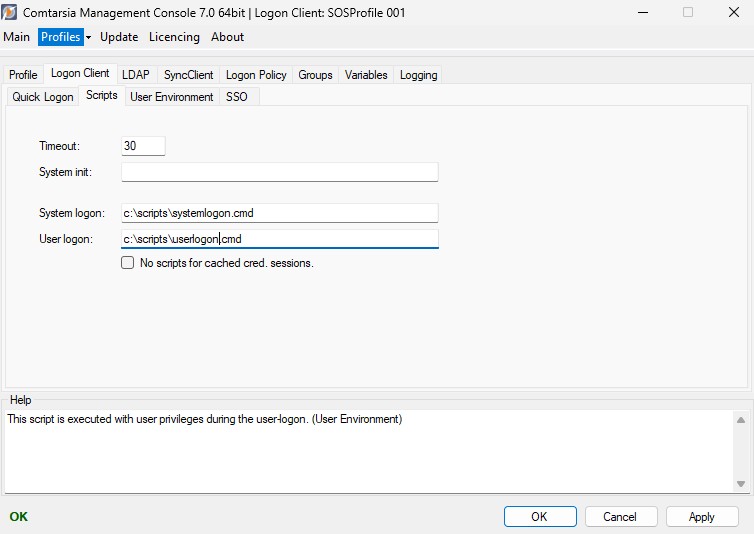
The Timeout parameter specifies the time in seconds within which the scripts have to complete before the Comtarsia Logon Client terminates them.
The System Init Script is run in the system context at the system startup.
The System Logon Script is run with system privileges in the system context at each logon.
The User Logon Script is run with user privileges in the user context at each logon.
If the parameter No Logon/Logoff scripts for cached cred. Sessions is enabled, the “logon scripts” will be inactive during an offline-/cached credentials logon.
User Environment
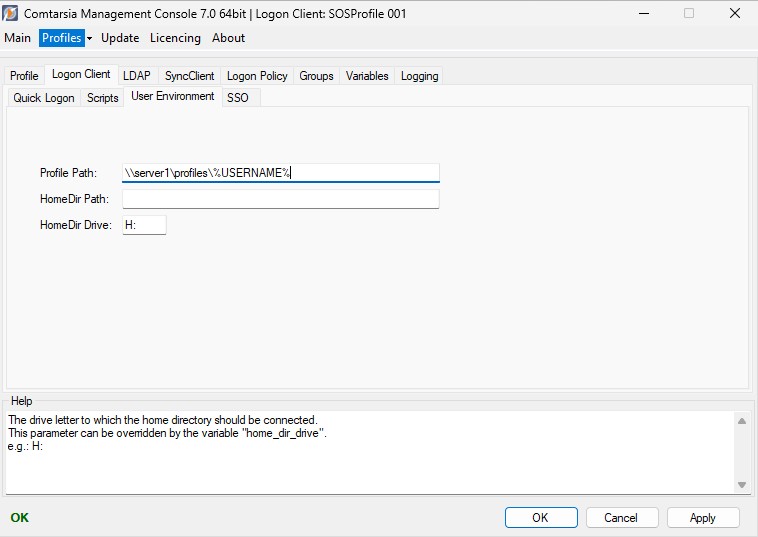
The parameter Profile Path specifies the path to the user profile which has to be assigned to local users.
The parameter HomeDir Path specifies which path should be assigned as local user’s as the “home dir path”.
The parameter HomeDir Drive defines which drive letter should be assigned as the local user’s “home dir drive”.
In “Domain user mode” (activated Enable Domain Logon), the Comtarsia Logon Client is unable to assign these values to the domain users (due to privileges).
Instead, the Comtarsia SignOn Gate (Agent Configuration) has to handle the user paths.
The default profile path can be assigned via the following value in the Windows System Registry:
HKLM\Software\Microsoft\Windows NT\CurrentVersion\ProfileList\Default
Useful tips about customizing default user profiles and mandatory user profiles can be found in this Microsoft article: http://support.microsoft.com/kb/973289/de
SSO
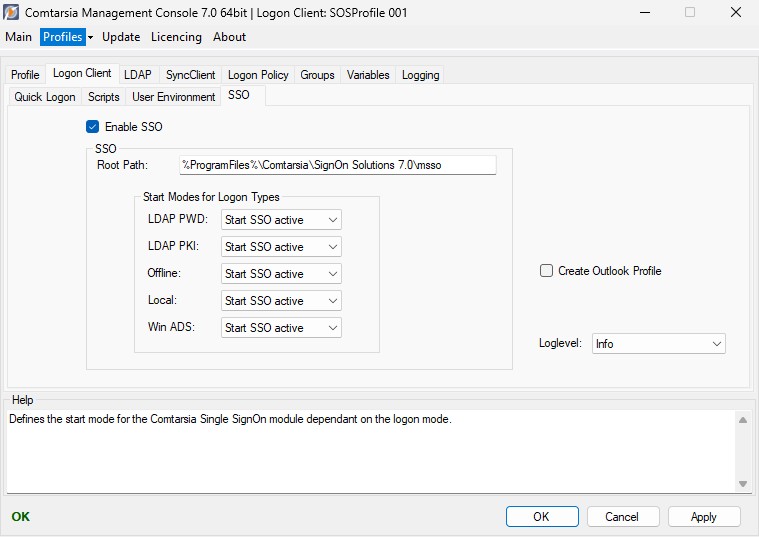
Enables the Comtarsia Managed Single SignOn (ComtMSSO) module. (this module has to be installed seperately)
Defines the path to the root directory of the ComtMSSO installation.
Start Modes for Logon Types
Specifies the desired start mode for the Comtarsia Single SignOn module dependant on the logon mode.
Start Modes:
- Don’t start SSO: The ComtMSSO module won’t be loaded
- Start SSO inactive: The ComtMSSO module will be loaded, but is set “inactive”. (The user can enable it via the tray icon, when needed)
- Start SSO active: The ComtMSSO module will be loaded normally.
Logon Types: (via the Comtarsia logon tile)
- LDAP PWD: LDAP-logon via user-password authentication
- LDAP PKI: LDAP-logon via smartcard/token authentication
- Offline: offline logon
- Local: local logon
- Win ADS: active directory logon
User Certificate
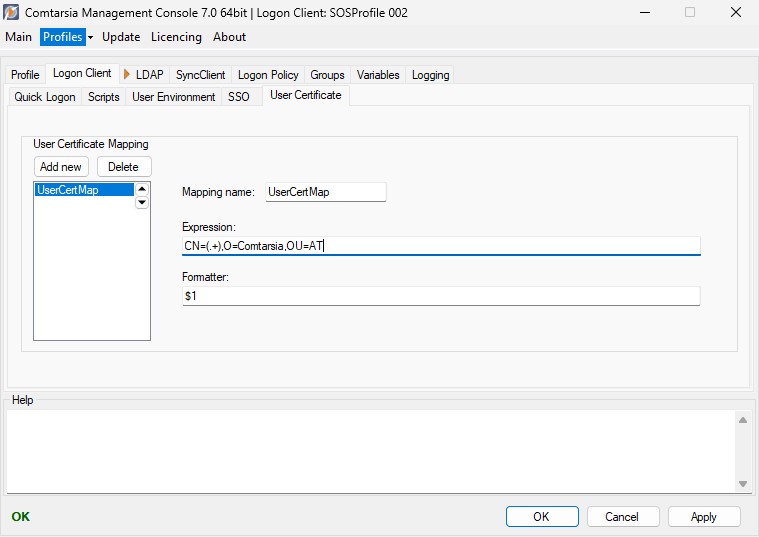
This tab is only available in PKI Mode. (see: Logon Client - General - Authentication mode)
A User Certificate Mapping specifies a regular expression to map the Certificate DN (subject) of the user to an LDAP user dn.
Several User Certificate Mappings can be defined which will be tried in order (top to bottom). The first matching expression will be used by the Logon Client to determine the LDAP user DN.
The Mapping name can be any name as it only serves organisational purposes.
The parameter Expression specifies the regular expression. If the certificates DN (subject) matches with this expression, the Formatter will be used to determine the resulting LDAP User. (The resulting string will be used to determine the LDAP User)
The parameter Formatter defines how to map the matching regular expression.
Example:
Expression: ^[Cc][Nn]=([^,]*),.*
Formatter: uid=$1,ou=users,dc=company,dc=com
Certificate DN: cn=mustermann, ou=example, cn=controling
Resulting LDAP DN: uid=musterman,ou=users,dc=company,dc=com
Certificate DN: cn=mustermann2, dc=company
Resulting LDAP DN: uid=musterman2,ou=users,dc=company,dc=com
6.2 LDAP
Server
LDAP server specific configuration.
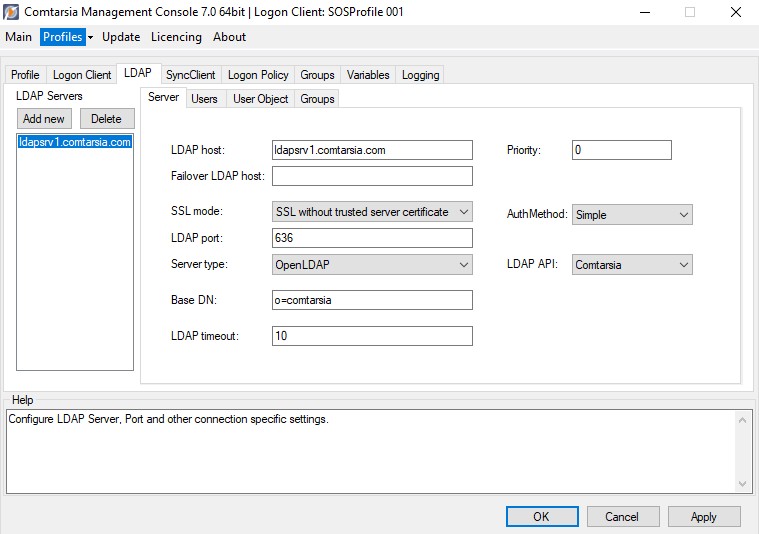
Specifies the primary LDAP server.
Specifies a failover LDAP server. This host will only be contacted if the first LDAP server couldn’t be reached.
This parameter specifies if, and which SSL mode should be used for the LDAP communication. (See: LDAP over SSL)
The port of the LDAP servers. (default: 389). If another SSL mode is used, the port has to be changed to that LDAP-SSL port. (default for SSL-communication: 636)
Defines which LDAP server software is in use. This is necessary so that the Comtarsia Logon Client is able to evaluate server specific responses properly (eg: LDAP password policy controls).
Specifies the baseDN of all LDAP-operations.
Specifies the timeout within which the LDAP-communication has to be finished; otherwise the logon process will be cancelled.
Users
The configuration of “how to determine the LDAP user”.
Static DN
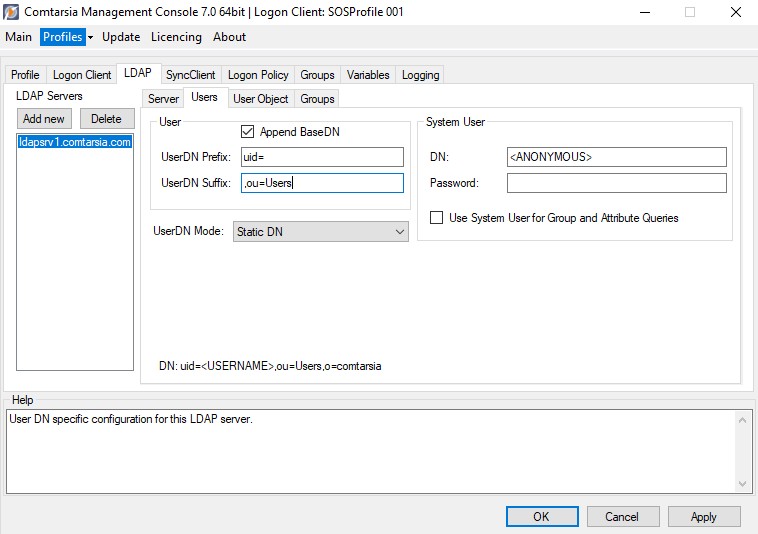
If this parameter is enabled, the BaseDN is appended to the UserDN. (Default and recommended)
Defines the naming attribute of the LDAP user. The specified value is used for the “Bind as User” operation (static DN), as well as for the LDAP user search (if enabled).
This suffix is appended to the user name for the “Bind as User” (static DN) operation.
UserDN Mode (searchForUser, ouSearchListMode)
Defines how the Logon Client should determine the LDAP DN of the LDAP user object. „Static DN“ defines that the UserDN should be constructed from the specified values, and that this resulting userDN should be used directly for the LDAP bind operation. (Also see: LDAP Users from Multiple OUs)
DN: Shows the resulting userDN which will be used for the LDAP bind; or, in case of a different “UserDN Mode”, the resulting LDAP search string.
Search for User
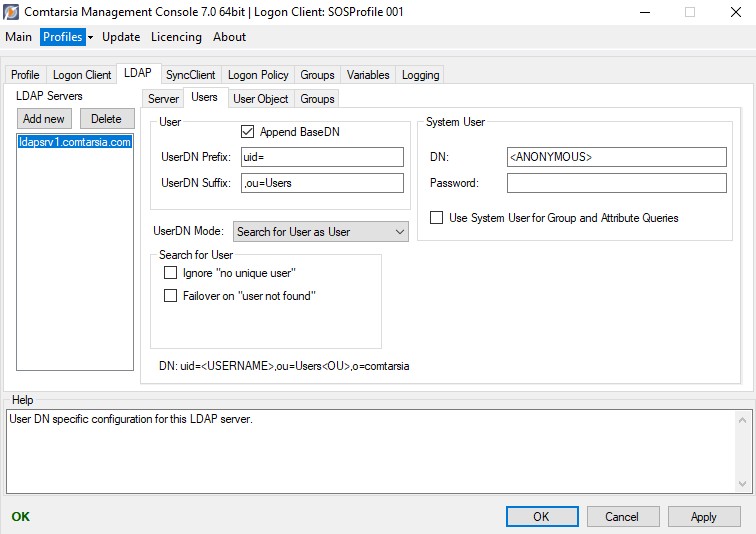
Defines a full LDAP DN of a dedicated LDAP system user which will be used for the LDAP search operation (Both for “UserDN Mode: Search for User”, and “UserDN Mode: OU Searchlist”). UserDN Modes, other than “static DN” are needed to find LDAP users in case they’re in different containers/OUs. (Also see: LDAP Users from Multiple OUs, und Search for User)
Defines the password of the LDAP system user. The password is stored encrypted.
OU Searchlist
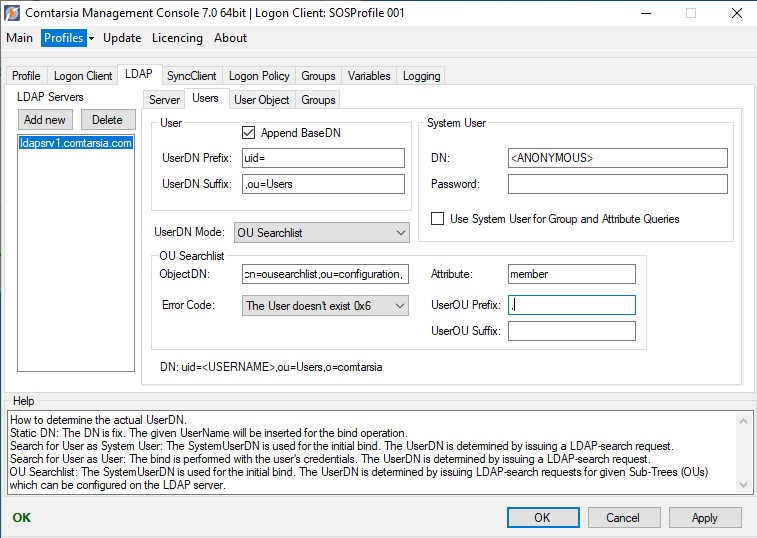
OU Searchlist
Also see: LDAP Users from Multiple OUs, und OU Searchlist
OU Searchlist > ObjectDN
Specifies which LDAP object contains the list of OUs (OU Searchlist).
OU Searchlist > Attribute
Specifies which LDAP attribute of that OU Searchlist LDAP object contains the single OU-values. (multivalue attribute)
OU Searchlist > Error Code
Defines which LDAP error should be returned in case the User wasn’t found in any of the OUs.
OU Searchlist > UserOU Prefix
Defines a prefix which will be used to construct the particular user DNs.
The possible UserDNs are constructed in the following way:
<UserDN Prefix><USERNAME><UserDN Suffix><UserOU Prefix><OU><UserOU Suffix>,<baseDN>
(Also see: LDAP Users from Multiple OUs, and OU Searchlist)
6.3 User Object
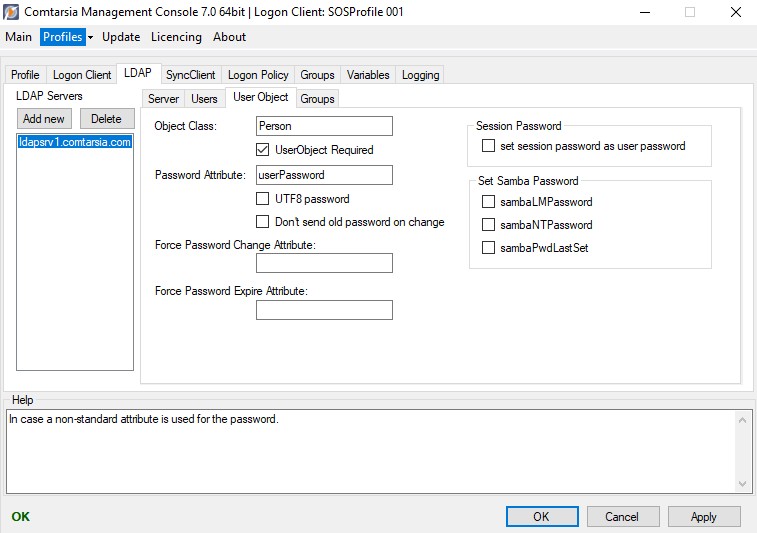
User Object
Defines which LDAP ObjectClass has to be used to determine the LDAP-user (for Search For User and OU Searchlist).
If this option is enabled, a logon will only be allowed if the LDAP-user was actually found in the LDAP directory. This usually isn’t necessary, unless the LDAP server allows bind requests of non-existent/wrong users.
Defines in which LDAP attribute of the LDAP user object the password is stored.
If this option is enabled, the password will be sent UTF8-encoded during the logon, as well as during password-changes. This also affects the system user password.
Don’t send old password on change
If this option is enabled, the old password won’t be sent together with the new password during a password change request. (Default: old password will be sent. Recommended)
The following options can be used to synchronize the LDAP user password with the Samba Password of the LDAP user object. This is useful if the LDAP user objects are also used as samba users.
Updates the LDAP user attribute “sambaLMPassword” with the LM-hash of the user password.
Updates the LDAP user attribute “sambaNTPassword” with the NT-hash of the user password.
Updates the LDAP user attribute “sambaPwdLastSet” with the current time stamp (at each logon), to avoid an expiration of the samba password.
Session Password
During a smartcard logon, a session password is generated (dependant on the session password mode), by using the user's private key. The generated session password will be set as Windows user password and if the Sync Client is enabled, it will also be sent to the SignOn Proxy for synchronisation.
The session password will be written into the configured "password attribute" of the LDAP user object. Warning: As the users don't know their generated session passwords, they won't be able to authenticate via the LDAP directory via user+password.
This value specifies a template for the generation of the session password. Following characters can be used:
| Char | Description |
| :--- | :-------------------------------------------------------- |
| L | lowercase character (a-z) |
| U | uppercase character (A-Z) |
| 9 | number (0-9) |
| S | special character !"#$%&'()*+,-./:;<=>?@[\]^_{|}~ | |R` | random (randomly one of L, U, 9 or S) |
This option sets the config "smartCardSessionPasswordMode" to 1. (interval mode). The interval mode ensures that the generated password stays the same over specified time spans, but also that different workstations generate the same session password. This prevents synchronisation/network-resource access problems if users work on different computers on the network.
Specifies the amount of 'validity units' a session password remains the same.
Specifies the unit of the "validity (amount)".
Specifies an offset in minutes. For example: A "validity: 1, validity units: days" password always changes at 0:00 each day. Via the offset, this point in time can be changed (in minutes).
6.4 Groups
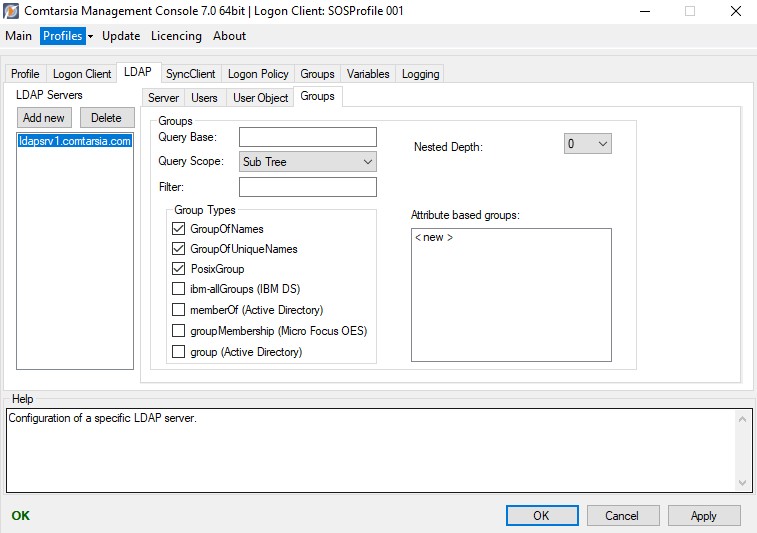
With this option, a different base DN can be defined for the group search. By default (if this option is empty), the configured LDAP > Server > Base DN is used.
Specifies the scope of the LDAP group search
- Base: Only the “Query Base” itself.
- One Level: All entries directly within the “Query Base”
- Sub Tree: The whole tree below the “Query Base”
Specifies an additional LDAP search filter which will be incorporated into the LDAP group search. Groups that do not match this filter will be left out.
With this, it’s possible to (examples):
- Check if a specific attribute is existant:
(description=*) - Check if an attribute starts with/ends with/contains a value:
(description=Logon*) - Check if an attribute has a specific value:
(GroupUsage=LogonGroup) - Check if one of several, or several group-requirements are met:
(|(GroupUsage=LogonGroup)(GroupUsage=WinGroup))
Specifies which types of groups the Comtarsia Logon Client has to look for. This configuration depends on the group types actually used on the LDAP server.
- GroupOfNames
- GroupOfUniqueNames
- PosixGroup
- ibm-AllGroups: a special LDAP user attribute, which only exists on IBM-Directory servers. (ignores Query Base and Filter)
- memberOf: a special LDAP user attribute, which only exists on Microsoft Active Directory servers (ignores Query Base and Filter)
With “attribute based groups”, it’s possible to use attributes of the LDAP user object as if they were groups.
For example, the LDAP user objects have an LDAP attribute "department", it is possible to define "department" as "attributes based group” and use the values of the LDAP attribute "department" as an additional group.
6.5 SyncClient
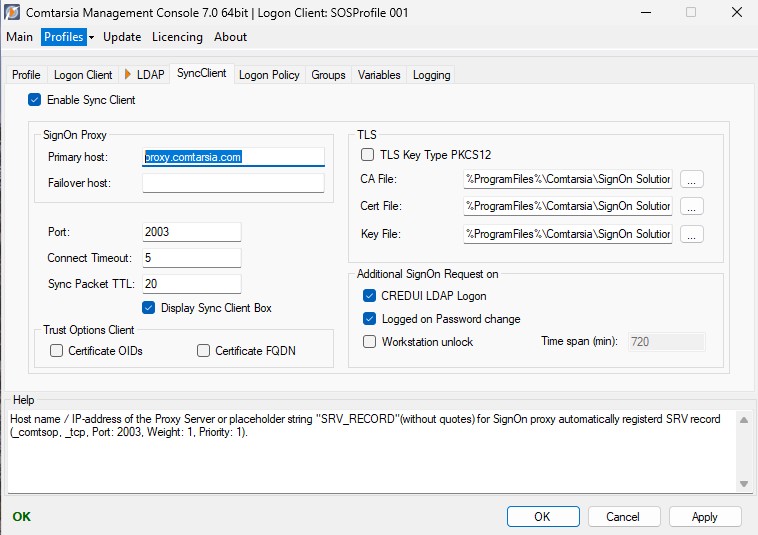
This option enables the Sync Client. After each successful logon, a Sync-User request will be sent to a specified Comtarsia SignOn Proxy.
SignOn Proxy
Specifies the IP-address or host name of the primary Comtarsia SignOn Proxy.
Specifies the IP-address or host name of a failover Comtarsia SignOn Proxy.
Specifies the IP-port for the communication to the SignOn Proxy. (default: 2003)
Specifies a connect-timeout in seconds.
Specifies a timeout in seconds for the whole synchronization process.
If this parameter is enabled, the status of the synchronization is displayed on the upper left corner of the logon screen.

TLS
This option specifies the path to the CA-certificate.
This option specifies the path to the user/computer-certificate.
This option specifies the path to the user/computer private key.
For more information about the Comtarsia Logon Client <-> SignOn Proxy communication, please refer to the manual Architectural Manual – SSL Certificates Chapter 2.1.
Additional SignOn Request on
If the parameter CREDUI LDAP Logon is enabled, a Sync-User request will also be sent after every successful CREDUI LDAP logon. (eg: For a Windows UAC)
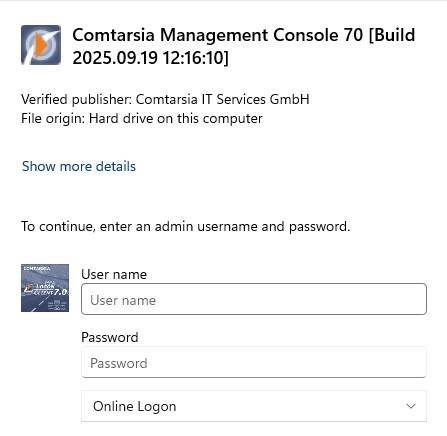
If the parameter Logged on Password change is enabled, a Sync-User request will also be sent after each LDAP-password change during an active logon session.
If the parameter Workstation Unlock is enabled, a Sync-User request will also be sent each time the workstation is unlocked. A time span that has to pass after the last Sync-User request before a new Sync-User request is sent, can be configured via Time span (min).
6.6 Logon
Logon Policy
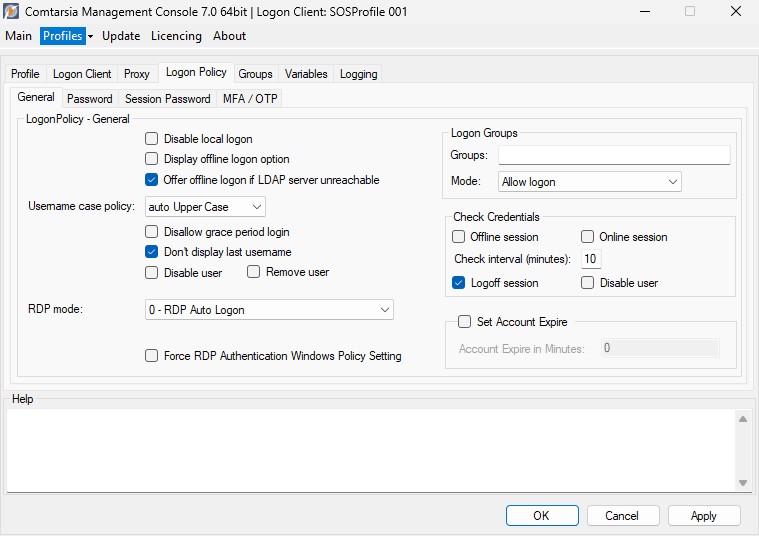
If the parameter Disable local logon is enabled, the option „LOCAL LOGON“ won’t be available on the logon form below the logon tile.
Offer offline logon if LDAP server unreachable
The parameter Username case policy specifies whether to force upper- or lower-case letters for the user name, or to allow upper and lower case letters on the logon form.
- No Case Policy: Upper- and lowercase is allowed.
- Auto Upper Case: All characters will be converted to upper case letters.
- Auto Lower Case: All characters will be converted to lower case letters.
If the option Disallow grace period login is enabled, a password change dialog which will be shown due to a “LDAP logon during the grace login period”, can’t be cancelled. (The cancel button is disabled)
If the parameter Don’t display last unsername is enabled, the username of the last successful logon won’t be shown in the logon form.
If the parameter Remove user is enabled, the local user and his/her user profile will be removed after logging off from an LDAP-logon session. This only affects users who have been created by the Comtarsia Logon Client during an LDAP-logon (marked with the user description: “SERV_TEMP_USER”).
In domain mode (i.e. there are no local users), this option is ignored. However, one may use the following Windows policy to remove local roaming profiles after each logon session: REG_DWORD:HKLM\Software\Policies\Microsoft\Windows\System\DeleteRoamingCache = 1
Logon Groups
Logon Groups can be used to allow/deny the logon of users, based on their LDAP group membership (LDAP groups, attribute based groups).
The field Groups contains a comma-separated list of group names.
The parameter Mode defines whether the membership of one of the Logon Groups is required for a logon, or forbids the logon. If the Groups list is empty, the Logon Groups functionality is inactive.
(See: LDAP-groups and parameter Attribute based groups)
Password
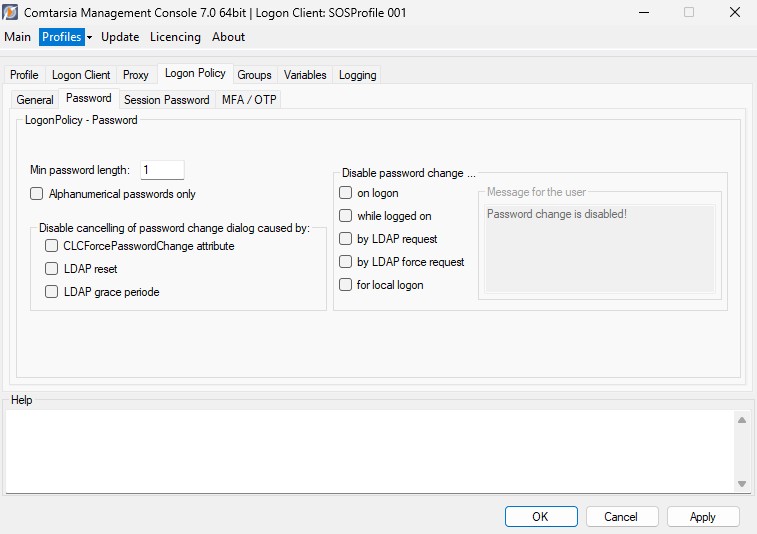
The parameter Min password length specifies the minimum length an LDAP password must have during a password change or an LDAP logon. If the current LDAP password is shorter, the user will be prompted to change it in order to log on.
The parameter Alphanumerical passwords only can be used to make sure that users can use alphanumeric characters only, in their passwords. (no special characters are allowed)
Cancelling of the password change dialog can be prevented in the following cases:
- CLCForcePasswordChange attribute: if the password dialog is shown due to the set LDAP attribute “CLCForcePasswordChange” of the LDAP user object.
- LDAP reset: if the password dialog is shown due a “must change on reset”-password policy control returned by the LDAP server.
- LDAP grace periode: if the password dialog is shown due to a “grace period login” (returned password policy control by the LDAP server).
It’s possible to prevent the password change in the following cases:
- on logon: via the check box “change password” on the logon screen
- while logged on: during a logged-on session. (Ctrl+Alt+Del screen)
- by LDAP request: if the LDAP server requested a password change (eg: via a “warn expire”).
- by LDAP force request: if the LDAP attribute “CLCForcePWDchange” is set for the LDAP user, or the LDAP server returned a “must change password” (eg: due to the LDAP password policy “must change on reset”).
- for local logon: during a local logon.
If a password change is prevented due to one of the aforementioned policies, the user will receive the message configured in Message for the user. This is useful if it’s required that the users change their LDAP passwords over a web interface.
Logon Info
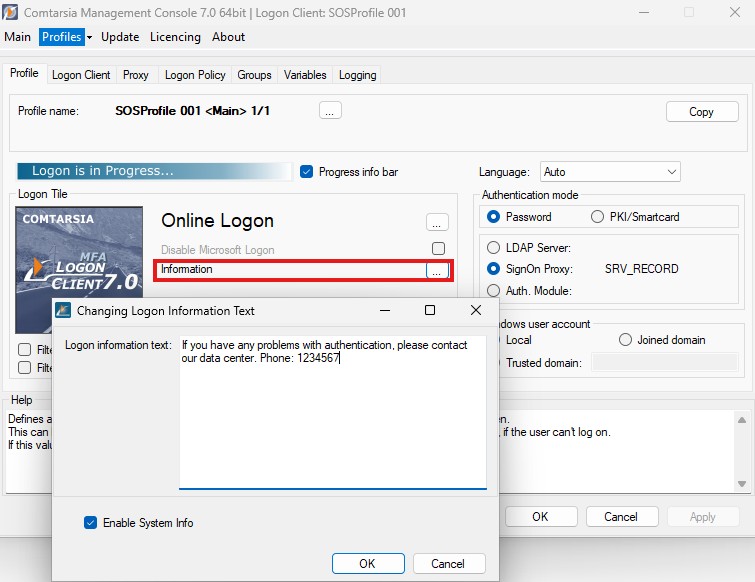
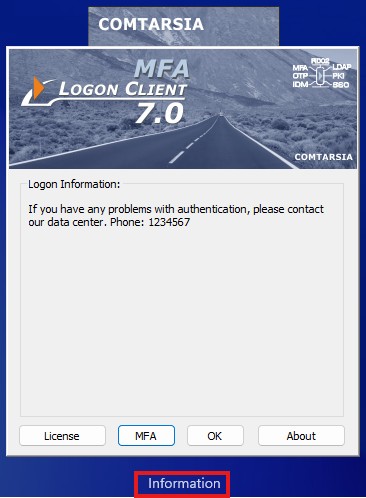
The parameter Logon Info Text specifies an alternative text users will see if they click on the “Information” link on the logon form. By default (if the text isn’t set), a generic text will be displayed. It’s suggested to enter support information, like a phone hotline, users need in case they can’t log on (eg: password expired, account locked, etc.)
6.7 PKI
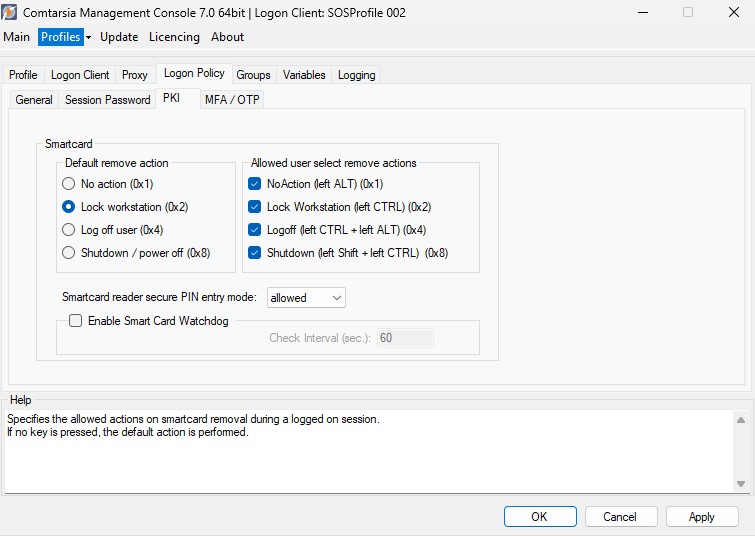
6.8 Groups - Groupmapping
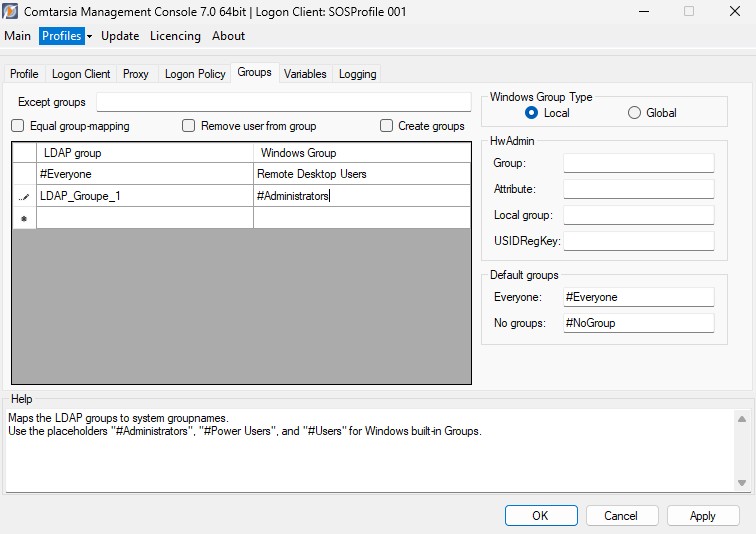
Using the group mapping function, the left column defines the LDAP group or placeholder, and the right column defines the local group on the Windows system to which the user should become a member.
The parameter Except groups defines a comma separated list of group names for which no operation should be carried out. (The user won't be added to, nor removed from these groups.)
The parameter Create groups defines if LDAP groups (or groups resulting from the group mapping), which don’t exist locally, should be created automatically.
The parameter Windows Group Type defines whether local or global groups should be used. "Global groups" can only be used on a windows domain controller. Global groups are domain global whereas local groups exist on the client computer only. On a client computer (any non-domain controller), this option has to be set to "Local".
If Equal group-mapping is enabled, the group names won't be altered by the mapping list. Each LDAP Group will be mapped to a system group one-to-one. Otherwise, a manual “group mapping” list can be specified. (also see: LDAP-groups and AttributeBasedGroups)
HwAdmin
The HwAdmin functionality allows to specify a list of computers of which a user is Administrator. The list is stored in a specified HwAdmin Attribute of the LDAP user object. The parameter HwAdmin Group specifies which LDAP-groups enables the “HwAdmin” functionality for a user.
The parameter HwAdmin Attribute specifies which LDAP attribute of the LDAP user object contains the list of computer names for which that user is an administrator. If both criterias are met, the user will be added to the local administrators group. (The name of that group has to be specified via the parameter LocalAdminGroup)
Default groups
Every user who successfully authenticated against the LDAP will be member of the dummy group specified in Everyone. This group can also be used in the group mapping list.
The parameter No groups specifies a dummy group which should be assigned to every sucessfully authenticated user who has no LDAP groups (inclusive AttributeBasedGroups) This group can also be used in the group mapping list.
6.9 Variables
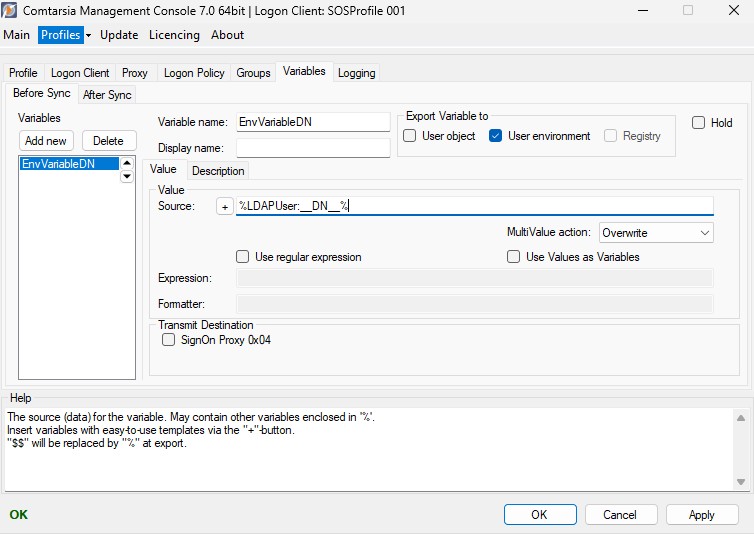
Variables are placeholders for variable values which can be obtained from different sources and processed and exchanged between the products within the Comtarsia product family. The values can also be exported to the respective target systems.
Examples for possible sources: LDAP user object; Windows registry, Computer environment variables, internally provided values.
Examples for possible export targets: Attributes of the Windows user object (ie. comment, home/profile path, full name); user environment.
The variables can be used/modified at two different points in time which are defined by the tabs "Before Sync" and "After Sync".
Before Sync: Variables will be accessed before the user synchronisation (thus they can also be sent to the SignOn Proxy/SignOn Agent)
After Sync: Variables will be processed after the user synchronisation Thus values can be sent back by the SignOn Agent/SignOn Proxy and processed.
The variables will also be processed in order (from top to bottom). The up/down arrow buttons can be used to change that order.
The Variable name specifies the name of the variable. If the value has to be exportet, the name has to match with the name of the target variable and/or the name of the target attribute.
The Display name specifies the name to be displayed in the variables list (at the left side). This parameter is used by the configuration utility only and is meant to help organising the variables.
Via "Export Variable to", variables can be exported to different target systems.
User object: The value of the user object (with the name of the value) will be set to the value of the variable.
User environment: The variable will be exported into the user environment (Windows environment variable).
With Hold variables can be disabled temporally.
Value
The Source defines the source/data of the variable. This field can contain text as well as other variables (between two '%'). To use '%' as part of the value '%%' has to be used and will be replaced by '%' rather than used as a variable. The "+" button offers a dialog to add easy-to-use variable source templates.
The MultiValue action defines how to handle multi value variables (variables which represent an array).
- Overwrite: A possibly existing value will be overwritten.
- Delete: The variable will be deleted.
- DeleteValue: The resulting value will be removed from the existing variable (array).
- AddValue: The resulting value will be added to the variable (array). (ie. to add a group to the existing list of groups)
Use regular expression enabled the 'regular expressions' functionality for this variable..
Expression defines the regular expression which has to be applied to the resolved value (content/data) of the source. If the source also contains variables, these will be replaced before the regular expression is applied.
The Formatter defines how to build the resulting value by applying the regular expression on the source value.
The Index can be used to refer to a specific match if a necessarily more ambiguous regular expression results in more than one match. Usually the index is 0 unless it's impossible to make the regular expression specific enough to result in only 1 match.
The Flags is a bitmask which specifies the operation mode of the regular expression.
Valid Flags:
match_default 0,
match_not_bol 0x00000001, /* first is not start of line */
match_not_eol 0x00000002, /* last is not end of line */
match_not_bob 0x00000004, /* first is not start of buffer */
match_not_eob 0x00000008, /* last is not end of buffer */
match_not_bow 0x00000010, /* first is not start of word */
match_not_eow 0x00000020, /* last is not end of word */
match_not_dot_newline 0x00000040, /* \n is not matched by '.' */
match_not_dot_null 0x00000080, /* '\0' is not matched by '.' */
match_prev_avail 0x00000100, /* *--first is a valid expression */
match_init 0x00000200, /* internal use */
match_any 0x00000400, /* don't care what we match */
match_not_null 0x00000800, /* string can't be null */
match_continuous 0x00001000, /* each grep match must continue */
/* uninterupted from the previous one */
match_partial 0x00002000, /* find partial matches */
match_stop 0x00004000, /* stop after first match (grep) V3 only */
match_not_initial_null 0x00004000, /* don't match initial null, V4 only */
match_all 0x00008000, /* must find the whole of input even if match_any is set */
match_perl 0x00010000, /* Use perl matching rules */
match_posix 0x00020000, /* Use POSIX matching rules */
match_nosubs 0x00040000, /* don't trap marked subs */
match_extra 0x00080000, /* include full capture information for repeated captures */
match_single_line 0x00100000, /* treat text as single line and ignor any \n's when matching ^ and $. */
match_unused1 0x00200000, /* unused */
match_unused2 0x00400000, /* unused */
match_unused3 0x00800000, /* unused */
match_max 0x00800000,
format_perl 0, /* perl style replacement */
format_default 0, /* ditto. */
format_sed 0x01000000, /* sed style replacement. */
format_all 0x02000000, /* enable all extentions to sytax. */
format_no_copy 0x04000000, /* don't copy non-matching segments. */
format_first_only 0x08000000, /* Only replace first occurance. */
format_is_if 0x10000000, /* internal use only. */
format_literal 0x20000000, /* treat string as a literal */
Transmit Destination
The Transmit Destination specifies to which other Comtarsia SignOn products this variable should be sent to. (Invalid destinations are greyed out)
If the Transmit Destination 'SignOn Agent 0x8' is set (only possible on the SignbOn Proxy) the option Domains can be used to specify to which SignOn Agent domains this variable should be sent. If this field is empty, the variable will be sent to all SignOn Agents.
7. Logging
[IMAGE PLACEHOLDER]
Log File
Enables/disables writing to the log file.
The LogLevel defines the verbosity of the log written to the specified file. The “detail log flags” are handled independently of the LogLevel. Eg: It’s perfectly valid to use “LogLevel”=None, and “Detail Log Flags”=Monitor to only log “monitoring”-messages.
- None: No logging, except detail log flags.
- Error: Only errors and specified detail log flags.
- Exception: As Error, and exception messages.
- Warn: As Exception, and warnings.
- Info: As Warn, and additional information
- Detail MSG: Everything (except unspecified log flags which have to be enabled separately)
Defines the path to the log file.
Defines the size at which the logfile should be rotated.
Defines the amount of logfiles to be rotated.
Detail Log Flags enable specific log output independent of the Loglevel. The Detail Log Flag "Monitor" is recommended for centralized monitoring.
Defines which details are to be included in each log line.
- Date
- Time
- PID & TID: Process and thread ID.
- Source pos: The position (line) in the source code.
[IMAGE PLACEHOLDER]
Enables/disables forward of log messages to a syslog server.
The LogLevel defines the verbosity of the log written to the specified file. The “detail log flags” are handled independently of the LogLevel. E.g.: It’s perfectly valid to use “LogLevel”=None, and “Detail Log Flags”=Monitor to only log “monitoring”-messages.
- None: No logging, except detail log flags.
- Error: Only errors and specified detail log flags.
- Exception: As Error, and exception messages.
- Warn: As Exception, and warnings.
- Info: As Warn, and additional information
- Detail MSG: Everything (except unspecified log flags which have to be enabled separately)
Defines the central SysLog host to which the SysLog messages will be sent.
Specifies the SysLog facility of the log messages.
Detail Log Flags enable specific log output independent of the Loglevel. The Detail Log Flag "Monitor" is recommended for centralized monitoring.
Defines which details are to be included in each log line.
- Date
- Time
- PID & TID: Process and thread ID.
- Source pos: The position (line) in the source code.
7.1 Licensing
[IMAGE PLACEHOLDER]
Displays information about the installed license key. The button “Load another license key” opens a file chooser dialog and copies the specified license key to the directory `%ProgramFiles%\Comtarsia\SignOn Solutions 7.0\Key.
8. Parameter Description
8.1 [HKLM\SOFTWARE\Comtarsia]
8.2 [.\SignOn Solutions 7.0]
path
path=REG_SZ:"C:\\Program Files\\Comtarsia\\SignOn Solutions 7.0"
Product installation directory.
8.3 [.\SignOn Solutions 7.0\Components]
8.4 [.\SignOn Solutions 7.0\DefaultProfiles]
LogonClient
LogonClient=REG_SZ:"SOSProfile 001"
8.5 [.\SignOn Solutions 7.0\LogonClient]
userInit
userInit=REG_SZ:"%SYSTEMROOT%\\system32\\userinit.exe"
credProvMode
credProvMode=REG_DWORD:0
detectedCredProvMode
detectedCredProvMode=REG_DWORD:0
displayCredProvConfig
displayCredProvConfig=REG_DWORD:0
8.6 [.\SOSProfile *]
language
language=REG_SZ:"Auto"
Language of the user interface. (Logon screen, messages)
profileName
profileName=REG_SZ:""
profileComment
profileComment=REG_SZ:""
profileConfigVersion
profileConfigVersion=REG_SZ:""
8.7 [.\SOSProfile *\Group]
Configuration of the system specific groups.
equalGroupMapping
equalGroupMapping=REG_DWORD:0
0: use the groupmapping list to map LDAP groups to system groups
1: use the LDAP groups 1:1 without mapping
exceptGroups
exceptGroups=REG_SZ:""
A comma seperated list of group names which should be ignored.
globalGroups
globalGroups=REG_DWORD:0
0: use local system groups
1: Use global groups (only valid on domain controllers)
HwAdminGroup
HwAdminGroup=REG_SZ:""
HwAdminAttribute
HwAdminAttribute=REG_SZ:""
HwAdminUSIDRegKey
HwAdminUSIDRegKey=REG_SZ:""
HwAdminSubOU
HwAdminSubOU=REG_SZ:""
localAdminGroup
localAdminGroup=REG_SZ:""
createGroups
createGroups=REG_DWORD:0
Create non-existing groups.
defaultEveryoneGroup
defaultEveryoneGroup=REG_SZ:"#Everyone"
A default group every LDAP user will be a member of. It can also be used with group mapping.
defaultNoGroup
defaultNoGroup=REG_SZ:"#NoGroup"
A default group every LDAP user who doesn't have any LDAP groups will be a member of.
8.8 [.\SOSProfile *\GroupMapping]
8.9 [.\SOSProfile *\LDAP]
8.10 [.\SOSProfile *\LDAP\Servers]
8.11 [.\SOSProfile *\LDAP\Servers\<LDAP-Server>]
The name of this key (
priority
priority=REG_DWORD:0
failoverHost
failoverHost=REG_SZ:""
baseDN
baseDN=REG_SZ:"o=comtarsia"
The LDAP baseDN
userDNPrefix
userDNPrefix=REG_SZ:"uid="
userDNSuffix
userDNSuffix=REG_SZ:",ou=sd"
userOUPrefix
userOUPrefix=REG_SZ:""
userOUSuffix
userOUSuffix=REG_SZ:""
userObjectClass
userObjectClass=REG_SZ:"Person"
userObjectRequired
userObjectRequired=REG_DWORD:0
userQueryScope
userQueryScope=REG_DWORD:2
groupTypes
groupTypes=REG_DWORD:7
groupQueryBase
groupQueryBase=REG_SZ:""
groupQueryScope
groupQueryScope=REG_DWORD:2
attributeBasedGroups
attributeBasedGroups=REG_MULTI_SZ:"System.String[]"
userPasswordAttribute
userPasswordAttribute=REG_SZ:"userPassword"
timeout
timeout=REG_DWORD:0xA
port
port=REG_DWORD:0x185
sslMode
sslMode=REG_DWORD:0
serverType
serverType=REG_DWORD:0x0
useUTF8Password
useUTF8Password=REG_DWORD:0
dontSendOldPasswordOnChange
dontSendOldPasswordOnChange=REG_DWORD:0
systemUserDN
systemUserDN=REG_SZ:""
systemUserPassword
systemUserPassword=REG_SZ:""
OUSearchListMode
OUSearchListMode=REG_DWORD:0
OUSearchListErrorCode
OUSearchListErrorCode=REG_DWORD:6
OUSearchListObjectDN
OUSearchListObjectDN=REG_SZ:""
OUSearchListAttribute
OUSearchListAttribute=REG_SZ:""
appendBaseDN
appendBaseDN=REG_DWORD:1
searchForUser
searchForUser=REG_DWORD:0
groupFilter
groupFilter=REG_SZ:""
ignoreNoUniqueUser
ignoreNoUniqueUser=REG_DWORD:0
failoverOnUserNotFound
failoverOnUserNotFound=REG_DWORD:0
setSessionPasswordasUserPassword
setSessionPasswordasUserPassword=REG_DWORD:0
followReferrals
followReferrals=REG_DWORD:1
8.12 [.\SOSProfile *\Log]
enable
enable=REG_DWORD:1
With this parameter, this logging-method can be enabled/disabled.
logFileName
logFileName=REG_SZ:"%ProgramFiles%\\Comtarsia\\SignOn Solutions 7.0\\log\\ComtRPCSrv.log"
logLevel
logLevel=REG_DWORD:4
Specifies the log level.
URGENCY_ERROR = 1,
URGENCY_EXCEPTION = 2,
URGENCY_WARN = 3,
URGENCY_INFO = 4,
URGENCY_MSG = 5,
logMask
logMask=REG_DWORD:0
logDetails
logDetails=REG_DWORD:0xFFFFFFFF
pecifies the log details.
logDetails = 0x0 = No log details
logDetails = 0x1 = Date
logDetails = 0x2 = Time
logDetails = 0x4 = Process and thread ids.
logDetails = 0x8 = Source postion
logDetails = 0xFFFFFFFF = All details
enableLogTransactions
enableLogTransactions=REG_DWORD:0
maxLogFileSize
maxLogFileSize=REG_DWORD:0xA00000
maxLogFileHistory
maxLogFileHistory=REG_DWORD:1
8.13 [.\SOSProfile *\Log\SysLog]
enable
enable=REG_DWORD:0
With this parameter, this logging-method can be enabled/disabled.
host
host=REG_SZ:""
Specifies the SysLog server.
facility
facility=REG_DWORD:10
Specifies the SysLog facility.
logLevel
logLevel=REG_DWORD:0
Specifies the log level.
URGENCY_ERROR = 1,
URGENCY_EXCEPTION = 2,
URGENCY_WARN = 3,
URGENCY_INFO = 4,
URGENCY_MSG = 5,
logMask
logMask=REG_DWORD:0
logDetails
logDetails=REG_DWORD:0x0
Specifies the log details.
logDetails = 0x0 = No log details
logDetails = 0x1 = Date
logDetails = 0x2 = Time
logDetails = 0x4 = Process and thread ids.
logDetails = 0x8 = Source postion
logDetails = 0xFFFFFFFF = All details
8.14 [.\SOSProfile *\SyncClient]
connectTimeout
connectTimeout=REG_DWORD:5
proxyPort
proxyPort=REG_DWORD:0x7D3
syncPacketTTL
syncPacketTTL=REG_DWORD:0x14
syncProxy1
syncProxy1=REG_SZ:""
syncProxy2
syncProxy2=REG_SZ:""
tlsCAFile
tlsCAFile=REG_SZ:"%ProgramFiles%\\Comtarsia\\SignOn Solutions 7.0\\cert\\ca.pem"
tlsCADir
vn=REG_SZ:""
tlsCertFile
tlsCertFile=REG_SZ:"%ProgramFiles%\\Comtarsia\\SignOn Solutions 7.0\\cert\\client.pem"
tlsKeyFile
tlsKeyFile=REG_SZ:"%ProgramFiles%\\Comtarsia\\SignOn Solutions 7.0\\cert\\client.key"
8.15 [.\SOSProfile *\UserCertificateMapping]
8.16 [.\SOSProfile *\UserCertificateMapping\ <UserCertificateMappingName>]
The name of this key (
expression
expression=REG_SZ:""
formatter
formatter=REG_SZ:""
8.17 [.\SOSProfile *\Variables]
8.18 [.\SOSProfile *\Variables\BeforeSync]
8.19 [.\SOSProfile *\Variables\AfterSync]
8.20 [.\SOSProfile *\Variables\<VariableEffectivePoint>]
The name of this key can be "BeforeSync" or "AfterSync" and defines when the variables under this key should be mapped.
8.21 [.\SOSProfile *\Variables\<VariableEffectivePoint>\<VariableName>]
The name of this key (
displayName
displayName=REG_SZ:""
variableComment
variableComment=REG_SZ:""
source
source=REG_SZ:""
transmitDestination
transmitDestination=REG_DWORD:0x0
exportDestination
exportDestination=REG_DWORD:0x0
transmitDestinationDomains
transmitDestinationDomains=REG_MULTI_SZ:"System.String[]"
mappingType
mappingType=REG_DWORD:0
expression
expression=REG_SZ:""
formatter
formatter=REG_SZ:""
index
index=REG_DWORD:0
flags
flags=REG_DWORD:0x2000000
multivalueAction
multivalueAction=REG_DWORD:0
0:Override
1:Delete
2:DeleteValue
3:AddValue
hold
hold=REG_DWORD:0
This option can be used to temporarily disable a variable mapping.
8.22 [.\SOSProfile *\UserEnvironment]
defaultUserProfile
defaultUserProfile=REG_SZ:""
profilePath
profilePath=REG_SZ:""
homeDirDrive
homeDirDrive=REG_SZ:"H:"
homeDirPath
homeDirPath=REG_SZ:""
8.23 [.\SOSProfile *\LogonClient]
displayProgressBox
displayProgressBox=REG_DWORD:1
enableSyncClient
enableSyncClient=REG_DWORD:0
displaySyncBox
displaySyncBox=REG_DWORD:1
WTSMode
WTSMode=REG_DWORD:0
ADSLogonMode
ADSLogonMode=REG_DWORD:0
winDomain
winDomain=REG_SZ:""
enableDomainLogon
enableDomainLogon=REG_DWORD:0
userinit
userinit=REG_SZ:"%SYSTEMROOT%\\system32\\userinit.exe"
GPUpdate_Mask
GPUpdate_Mask=REG_DWORD:0
GPUpdate_CMD
GPUpdate_CMD=REG_SZ:""
disableMsCredProviderToggle
disableMsCredProviderToggle=REG_DWORD:0
unregisterMsCredProvider
unregisterMsCredProvider=REG_DWORD:0
panelBitmap
panelBitmap=REG_SZ:""
refreshUnlockTimer
refreshUnlockTimer=REG_DWORD:720
removeUser
removeUser=REG_DWORD:0
bitmask: (only for local mode)
0x1 User Account
0x2 Profile // (0x1 User Account, 0x2 Profile), only local mode.
LDAPSetPasswordAsSambaPassword
LDAPSetPasswordAsSambaPassword=REG_DWORD:0
enableSmartCard
enableSmartCard=REG_DWORD:0
smartCardDefaultRemoveAction
smartCardDefaultRemoveAction=REG_DWORD:2
smartCardRemoveActionUserSelectMask
smartCardRemoveActionUserSelectMask=REG_DWORD:0xF
logonPanelTileDisplayName
logonPanelTileDisplayName=REG_SZ:""
enableProxyLogon
enableProxyLogon=REG_DWORD:0
sessionPasswordTemplate
sessionPasswordTemplate=REG_SZ:"LLUURR99SS"
smartCardSessionPasswordMode
smartCardSessionPasswordMode=REG_DWORD:0
smartCardSessionPasswordValidity
smartCardSessionPasswordValidity=REG_DWORD:1
smartCardSessionPasswordValidityUnits
smartCardSessionPasswordValidityUnits=REG_DWORD:0
smartCardSessionPasswordValidityOffset
smartCardSessionPasswordValidityOffset=REG_DWORD:0
smartCardSecurePINEntryMode
smartCardSecurePINEntryMode=REG_DWORD:1
displayMsgStrID
displayMsgStrID=REG_DWORD:0
8.24 [.\SOSProfile *\LogonPolicy]
minPwdLen
minPwdLen=REG_DWORD:0
alphaNumPwd
alphaNumPwd=REG_DWORD:0
userNameCasePolicy
userNameCasePolicy=REG_DWORD:1
disablePasswordChange
disablePasswordChange=REG_DWORD:0
disableLocalLogon
disableLocalLogon=REG_DWORD:0
changePasswordInfo
changePasswordInfo=REG_SZ:"Password change is disabled!"
denyCancelForcePWDChangeDlg
denyCancelForcePWDChangeDlg=REG_DWORD:0
disallowGraceLogin
disallowGraceLogin=REG_DWORD:0
dontDisplayLastUserName
dontDisplayLastUserName=REG_DWORD:0
logonAllowGroups
logonAllowGroups=REG_SZ:""
negateLogonAllowGroups
negateLogonAllowGroups=REG_DWORD:1
enableWkstLogonPolicy
enableWkstLogonPolicy=REG_DWORD:0
wkstLogonPolicyRetryTimer
wkstLogonPolicyRetryTimer=REG_DWORD:60
wkstLogonPolicyRootOUGroups
wkstLogonPolicyRootOUGroups=REG_MULTI_SZ:"System.String[]"
logonInformationText
logonInformationText=REG_SZ:""
offerOfflineLogonByUnreachableLDAP
offerOfflineLogonByUnreachableLDAP=REG_DWORD:1
offerOfflineLogonAsLogonOption
offerOfflineLogonAsLogonOption=REG_DWORD:0
enableQuickLogon
enableQuickLogon=REG_DWORD:0
quickLogonButtonCaption
quickLogonButtonCaption=REG_SZ:""
quickLogonUser
quickLogonUser=REG_SZ:""
quickLogonPassword
quickLogonPassword=REG_SZ:""
quickLogonDomain
quickLogonDomain=REG_SZ:""
disableRdpAutoLogon
disableRdpAutoLogon=REG_DWORD:0
setAsDefaultLogonTile
setAsDefaultLogonTile=REG_DWORD:1
8.25 [.\SOSProfile *\Script]
userLogon
userLogon=REG_SZ:""
userLogoff
userLogoff=REG_SZ:""
systemLogon
systemLogon=REG_SZ:""
systemLogoff
systemLogoff=REG_SZ:""
systemInit
systemInit=REG_SZ:""
timeout
timeout=REG_DWORD:0x1E
noScriptByCachedCredLogon
noScriptByCachedCredLogon=REG_DWORD:0
8.26 [.\SOSProfile *\SSO]
rootPath
rootPath=REG_SZ:"%PROGRAMFILES%\\Comtarsia\\ComtMSSO"
enableSSO
enableSSO=REG_DWORD:0
LDAP_PWD_MODE
LDAP_PWD_MODE=REG_DWORD:2
LDAP_PKI_MODE
LDAP_PKI_MODE=REG_DWORD:2
OFFLINE_MODE
OFFLINE_MODE=REG_DWORD:2
LOCAL_LOGON_MODE
LOCAL_LOGON_MODE=REG_DWORD:2
WIN_ADS_MODE
WIN_ADS_MODE=REG_DWORD:2
9. 8. Disclaimer
All pages are subject to copyright and may only be copied or integrated in own offers with the written permission of Comtarsia IT Services.
All Rights reserved.
Subject to changes without notice!
Comtarsia IT Services does not give any assurance or guarantee for other websites, to which we refer in this manual. If you access a non-Comtarsia IT Services Website, it is an independent site beyond our control.
This is also valid, if this site contains the Comtarsia IT Services logo.
In addition, a link from our site to another does not mean that we identify ourselves with their content or support their use.
